
|
Chemically active as well as chemically inactive (inert) additives can be added for targeted influencing of the drilling fluid or of the water as the fluid’s base. According to DIN V 4126-100 [HDD-222], chemically active additives also called mixing media, are added to the drilling fluid with the aim of changing its mechanical properties, especially their flow, penetration and stabilising behaviour. Among the additives are filtrate reducers (see (… |
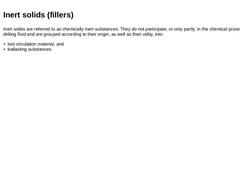
|
Inert solids are referred to as chemically inert substances. They do not participate, or only partly, in the chemical processes in the drilling fluid and are grouped according to their origin, as well as their utility, into: -
lost circulation material, and
-
ballasting substances.
|
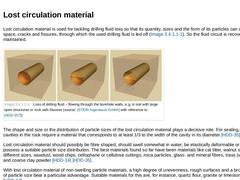
|
Lost circulation material is used for tackling drilling fluid loss so that its quantity, sizes and the form of its particles can close the pore space, cracks and fissures, through which the used drilling fluid is led off (Figure 136). So the fluid circuit is recovered or maintained. (Image: Loss of drilling fluid – flowing through the borehole walls, e.g. in soil with large open structures or rock with fissures) The shape and size or the distribution … |
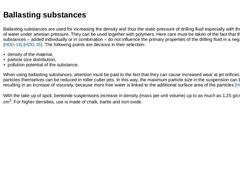
|
Ballasting substances are used for increasing the density and thus the static pressure of drilling fluid especially with the occurrence of water under artesian pressure. They can be used together with polymers. Here care must be taken of the fact that these substances – added individually or in combination – do not influence the primary properties of the drilling fluid in a negative way [HDD-14] [HDD-35]. The following points are decisive in their … |
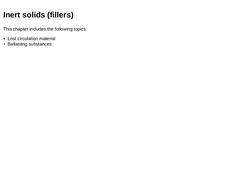
|
Inert solids are referred to as chemically inert substances. They do not participate, or only partly, in the chemical processes in the drilling fluid and are grouped according to their origin, as well as their utility, into: -
lost circulation material, and
-
ballasting substances.
|
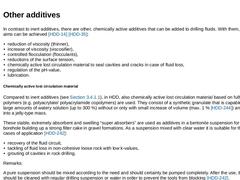
|
In contrast to inert additives, there are other, chemically active additives that can be added to drilling fluids. With them, the following aims can be achieved [HDD-14] [HDD-35]: -
reduction of viscosity (thinner),
-
increase of viscosity (viscosifier),
-
controlled flocculation (flocculants),
-
reductions of the surface tension,
-
chemically active lost circulation material to seal cavities and cracks in case of fluid loss,
-
regulation of the pH-value,
|
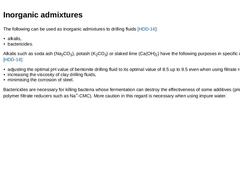
|
The following can be used as inorganic admixtures to drilling fluids [HDD-14]: Alkalis such as soda ash (Na2CO3), potash (K2CO3) or slaked lime (Ca(OH)2) have the following purposes in specific cases [HDD-14]: -
adjusting the optimal pH value of bentonite drilling fluid to its optimal value of 8.5 up to 9.5 even when using filtrate reducers,
-
increasing the viscosity of clay drilling fluids,
-
minimising the corrosion of steel.
|

|
Chemically active as well as chemically inactive (inert) additives can be added for targeted influencing of the drilling fluid or of the water as the fluid’s base. According to DIN V 4126-100 [HDD-222], chemically active additives also called mixing media, are added to the drilling fluid with the aim of changing its mechanical properties, especially their flow, penetration and stabilising behaviour. Among the additives are filtrate reducers (see (… |
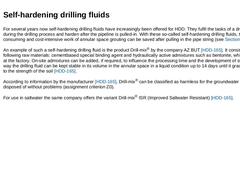
|
For several years now self-hardening drilling fluids have increasingly been offered for HDD. They fulfil the tasks of a drilling fluid during the drilling process and harden after the pipeline is pulled-in. With these so-called self-hardening drilling fluids, the time-consuming and cost-intensive work of annular space grouting can be saved after pulling in the pipe string (see (Annular space grouting)). An example of such a self-hardening drilling … |
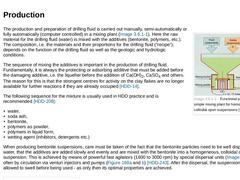
|
(Image: Functional principle of a simple mixing plant for homogeneous, collodial open suspensions)The production and preparation of drilling fluid is carried out manually, semi-automatically or fully automatically (computer controlled) in a mixing plant (Figure 168). Here the raw material for the drilling fluid (water) is mixed with the additives (bentonite, polymers, etc.). The composition, i.e. the materials and their proportions for the drilling … |
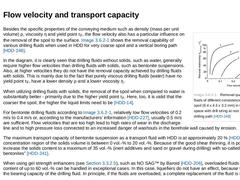
|
(Image: Removal quantities of drilling fluids of different consistencies for model spoil (6.4 x 4.3 x 3.2 mm) in the annular space with drill string at rest and vertical drilling path)Besides the specific properties of the conveying medium such as density (mass per unit volume) ρ, viscosity η and yield point τF, the flow velocity also has a particular influence on the removal of the spoil to the surface. Figure 172 shows the removal capability of … |
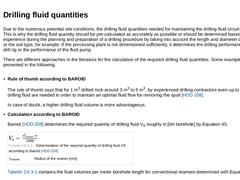
|
Due to the numerous potential site conditions, the drilling fluid quantities needed for maintaining the drilling fluid circuit in HDD vary. This is why the drilling fluid quantity should be pre-calculated as accurately as possible or should be determined based on practical experience during the planning and preparation of a drilling procedure by taking into account the length and diameter of the borehole or the soil type, for example. If the processing … |
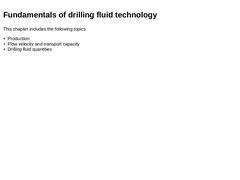
|
|
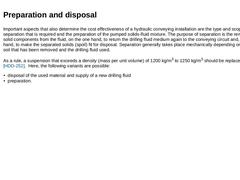
|
Important aspects that also determine the cost effectiveness of a hydraulic conveying installation are the type and scope of the separation that is required and the preparation of the pumped solids-fluid mixture. The purpose of separation is the removal of the solid components from the fluid, on the one hand, to return the drilling fluid medium again to the conveying circuit and, on the other hand, to make the separated solids (spoil) fit for disposal. … |
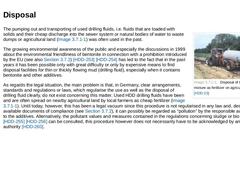
|
(Image: Disposal of the solid-fluid mixture as fertilizer on agricultural land)The pumping out and transporting of used drilling fluids, i.e. fluids that are loaded with solids and their cheap discharge into the sewer system or natural bodies of water to waste dumps or agricultural land (Figure 173) was often used in the past. The growing environmental awareness of the public and especially the discussions in 1999 about the environmental friendliness … |
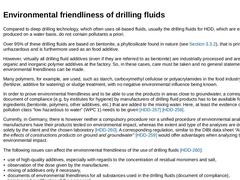
|
Compared to deep drilling technology, which often uses oil-based fluids, usually the drilling fluids for HDD, which are exclusively produced on a water basis, do not contain pollutants a priori. Over 95% of these drilling fluids are based on bentonite, a phyllosilicate found in nature (see (Bentonite drilling mud)), that is primarily unhazardous and is furthermore used as an food additive. However, virtually all drilling fluid additives (even if they … |
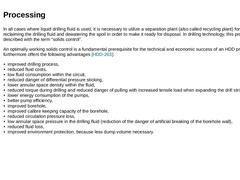
|
In all cases where liquid drilling fluid is used, it is necessary to utilize a separation plant (also called recycling plant) for cleaning and reclaiming the drilling fluid and dewatering the spoil in order to make it ready for disposal. In drilling technology, this process is described with the term “solids control”. An optimally working solids control is a fundamental prerequisite for the technical and economic success of an HDD project and furthermore … |
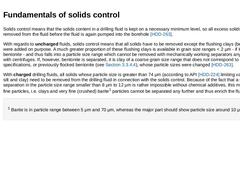
|
Solids control means that the solids content in a drilling fluid is kept on a necessary minimum level, so all excess solids must be removed from the fluid before the fluid is again pumped into the borehole [HDD-263]. With regards to uncharged fluids, solids control means that all solids have to be removed except the flushing clays (bentonite) that were added on purpose. A much greater proportion of these flushing clays is available in grain size ranges < … |
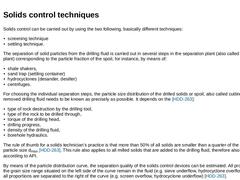
|
Solids control can be carried out by using the two following, basically different techniques: -
screening technique
-
settling technique.
The separation of solid particles from the drilling fluid is carried out in several steps in the separation plant (also called recycling plant) corresponding to the particle fraction of the spoil, for instance, by means of: -
shale shakers,
-
sand trap (settling container)
-
hydrocyclones (desander, desilter)
-
centrifuges.
|
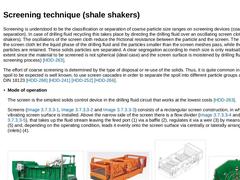
|
Screening is understood to be the classification or separation of coarse particle size ranges on screening devices (coarse separation). In case of drilling fluid recycling this takes place by directing the drilling fluid over an oscillating screen cloth (shale shakers). The oscillations of the screen cloth reduce the frictional resistance between the particle and the screen. The openings of the screen cloth let the liquid phase of the drilling fluid … |
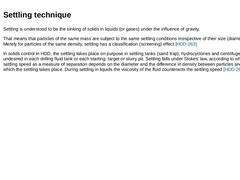
|
Settling is understood to be the sinking of solids in liquids (or gases) under the influence of gravity. That means that particles of the same mass are subject to the same settling conditions irrespective of their size (diameter, volume). Merely for particles of the same density, settling has a classification (screening) effect [HDD-263]. In solids control in HDD, the settling takes place on purpose in settling tanks (sand trap), hydrocyclones and … |

|
The simplest and most economic separation of solids from the liquid phase is the use of sedimentation by means of sand traps. According to DIN 18123 [HDD-268], sedimentation is the settling of particles of a soil in a fluid. In the case of the settling basin or container, sedimentation is the result of the gravitational force (natural force of gravity, g-factor = 1) acting on the particles, on the one hand, and a reduction of the flow velocity resulting … |

|
In the case of HDD applications, hydrocyclones or centrifugal separators serve the purpose of separating solid particles contained in the drilling fluid. Here, the fluid is put into rotating motion. The centrifugal forces affecting the particles cause them to move radially to the outside. In this way they are separated from the fluid flow, which is siphoned off towards the inside. Hydrocyclones belong to the standard equipment of a fluid processing … |

|
(Image: Correct (a) and faulty (b, c) installation of hydrocyclones in fluid circles)The proper integration of the hydrocyclones into the fluid circuit and the dimensioning of the tank system are of decisive importance for the success and the efficiency of the entire processing (Figure 193). When installing hydrocyclones, attention must be paid to the fact that the devices process approx. 125% of the fluid volume (flow rate factor 1.25) in order to … |
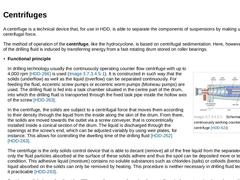
|
A centrifuge is a technical device that, for use in HDD, is able to separate the components of suspensions by making use of centrifugal force. The method of operation of the centrifuge, like the hydrocyclone, is based on centrifugal sedimentation. Here, however, the rotation of the drilling fluid is induced by transferring energy from a fast rotating drum stored on roller bearings. |